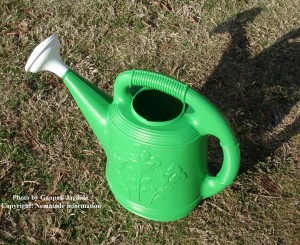Nematodes require special care and there are several methods of applications. The process depends on how the Nematodes come when you purchase them. It is also important to know how many nematodes need to be applied to be effective (See Table 1). This post is an overview or what is required for effective use of nematodes.
What kind of equipment is used for application of entomopathogenic nematodes?
- To apply liquid (Sponge) formulated Steinernema carpocapsae or Heterorhabdtis bacteriophora nematodes on a large area (>5000 sq ft) you can use traditional Knapsack/backpack sprayers or any other sprayers with up to 300 PSI pressures that are generally used for application of chemical pesticides.
- To apply liquid formulated Steinernema carpocapsae or Heterorhabdtis bacteriophora nematodes on a small areas (<5000 sq ft) such as vegetable and ornamental gardens you can use simple watering cans (shown in photo below).
- To apply granule formulated Steinernema carpocapsae nematodes on a small (<5000 sq ft) or large area (>5000 sq ft) you can use traditional spreaders that are used for application of granular or pallet pesticides or synthetic fertilizers.
How are nematodes applied?
- As stated above, entomopathogenic nematodes that you receive in sponge as liquid formulation are thoroughly mixed in water and can be easily sprayed on grass foliage with the traditional Knapsack/backpack sprayers or watering cans.
- However, at time of spraying care should be taken that the nematodes should not be allowed to settle at the bottom of sprayer or watering can to avoid their uneven distribution.
- To avoid the settling of nematodes at the bottom of sprayer or watering can, nematode suspension should be constantly agitated.
- However, nematodes will be easily damaged, if they are agitated through excessive recirculation of spray mix or if the temperature in the tank increases beyond 86oF.
- Nematodes can also be applied through different types of irrigation systems but pumps should have proper pressure to avoid damage to nematodes and screen sizes should be larger than 50 mesh so that nematodes will pass through them live.
- Nematodes received in granular formulation can be directly applied using traditional spreaders that are used for application of granular or pallet pesticides or synthetic fertilizers.

Watering can for application of entomopathogenic nematodes on a small area
When to apply nematodes
- To target any soil dwelling stages of insect pests, entomopathogenic nematodes should be applied when young larval (caterpillars)/ nymphal stages (instars) of insects are already hatched from eggs and started feeding on grass leaves or any other crops.
- Since nematodes are very sensitive to UV light, they will die within a minute or two when exposed to full sun. Therefore, nematodes should be applied early in the morning or late in the evening to avoid exposure to UV light.
- Another advantage of applying nematodes late in the evening is that caterpillars/larvae of most of the insect pests can be easily targeted because they are generally active and searching for food during night and easily found by entomopathogenic nematodes like Steinernema carpocapsae that uses sit and wait (ambush) strategy to attack its passing by host. Since caterpillars of many insects are moving actively during night in search of food or larvae of those insects remaining at one place and continuously feeding plant roots, can easily come across to entomopathogenic nematodes like Heterorhabdits bacteriophora or other species of Heterorhabditis that uses cruising strategy to finds its host. Heterorhabditis nematodes can also find caterpillars that are hiding under thatch during day time.
What care should be taken before and after application of nematodes?
- All nematodes require proper soil moisture for their optimal movement and infectivity.
- The activity and infectivity of nematodes can be enhanced by maintaining optimum moisture levels in the soil before and after their application.
- In case of nematode application in turf, turf should be irrigated immediately after application with at least 1/2 inch of water to rinse off nematodes from the foliage and move them into the soil and thatch.
- As nematodes are very sensitive to heat and cold, their infectivity will be reduced if soil temperature is below 4oC (39.2oF) and above 35oC (95.2oF).
- Soil temperatures between 20 to 30oC (68 to 86oF) are considered favorable for application of majority of nematode species and their virulence.
How many nematodes should be applied?
- For the successful control most of the soil dwelling insect pests, the optimal rate of 1 billion infective juvenile nematodes in 100 to 260 gallons of water per acreis generally recommended (Table 1).
Table1. Number of nematodes required to treat different sizes [area in sqft (sq M)] of lawns.Nematode species
Area in sq ft (sq meter)
1 (0.093)
10.76 (1)
108 (10)
1076 (100)
2500 (233)
5000 (465)
10000 (930)
43560 (4047) (an acre)
Heterorhabdtis bacteriophora
22.9 thousand
229.6 thousand
2.3 million
22.6 million 57.4 million 114.8 million 229.6 million 1.0 billion Heterorhabdtis indica
22.9 thousand
229.6 thousand
2.3 million
22.6 million 57.4 million 114.8 million 229.6 million 1.0 billion Steinernema carpocapsae
22.9 thousand
229.6 thousand
2.3 million
22.6 million 57.4 million 114.8 million 229.6 million 1.0 billion Steinernema feltiae
22.9 thousand
229.6 thousand
2.3 million
22.6 million 57.4 million 114.8 million 229.6 million 1.0 billion
